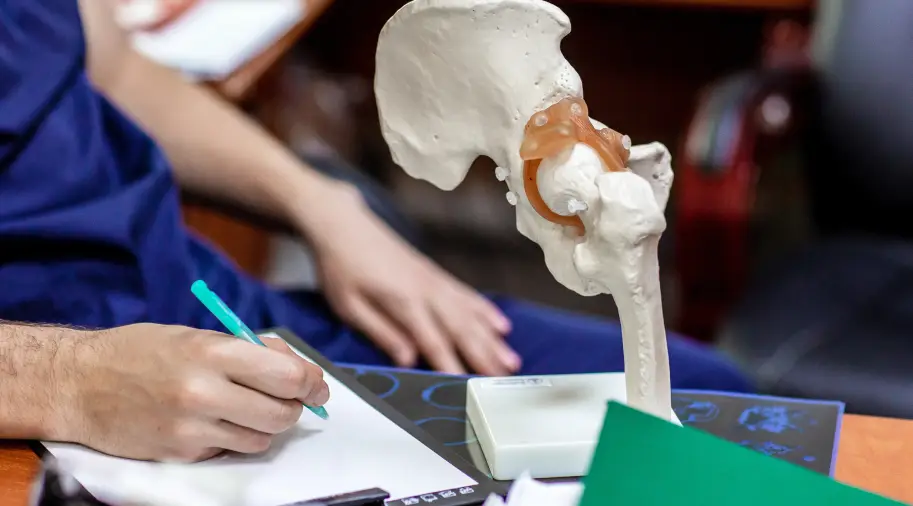Most people assume hip pain comes from arthritis or overuse, but instability of the hip joint is a subtler and often overlooked culprit. Unlike stiffness or inflammation, instability reflects a loss of control—where the ball of the hip joint moves in ways it shouldn’t. For active adults and older patients alike, this can quietly erode mobility, balance, and confidence. Understanding what causes hip instability, and how it can be treated, is the first step toward long-term joint health.
What Is Hip Instability? An Overlooked Problem
Hip instability is not just about pain—it’s about the joint moving in ways that feel unpredictable or unsafe. Some patients describe it as the hip “slipping,” “giving way,” or clicking with certain movements. What makes it especially overlooked is that these sensations can come and go, leading many to dismiss them as normal aging or muscle strain. In reality, instability often signals a deeper problem with the structures that keep the hip steady, including the labrum, ligaments, or bone alignment. Unlike arthritis, which is easier to see on an X-ray, instability can be subtle and may only appear during movement, making it harder to diagnose without specialized evaluation.
The Most Common Causes of Hip Instability
Hip instability often arises from a combination of structural, soft tissue, and functional issues. While some causes are widely recognized, many are subtle and rarely discussed, making them easy to overlook. Understanding these underlying factors can help patients and clinicians identify instability early and take steps to protect the joint.
- Labral Tears and Hip Instability
The labrum is a ring of cartilage that deepens the hip socket and provides stability. When it tears—sometimes from minor trauma or repetitive motion—the hip can feel loose or catch during movement. Labral damage is often underdiagnosed because pain may be intermittent or confused with a strain. - Ligament Laxity and Capsular Weakness
The ligaments and capsule surrounding the hip act like straps that hold the joint in place. Some people have naturally looser ligaments, while others develop laxity from injury or overuse. This “microinstability” is often subtle, showing up as clicking, popping, or a sensation that the hip isn’t fully supported during activity. - Hip Dysplasia in Adults
Hip dysplasia occurs when the hip socket doesn’t fully cover the ball of the joint. Many adults have mild, undiagnosed dysplasia from childhood that only causes problems later in life. Even small misalignments can lead to instability, labral tears, and early cartilage wear. - Femoroacetabular Impingement (FAI) and Bone Alignment Issues
Abnormal bone shapes—like extra bone on the femoral head or shallow sockets—can interfere with smooth joint motion. Over time, this misalignment stresses the labrum and surrounding tissues, reducing stability and creating pain during rotation or deep bending. - Post-Injury or Muscle Weakness
Trauma, repetitive strain, or prolonged inactivity can weaken the muscles that support the hip. When these stabilizing muscles lose strength or coordination, the joint can move unpredictably. Patients often notice instability after recovering from a hip strain, fall, or hip surgery. - Combination Factors
Many cases involve multiple contributors—such as a labral tear plus mild dysplasia—making instability more pronounced. These overlapping causes are often missed in routine evaluations, emphasizing the importance of a comprehensive assessment for accurate diagnosis.
When Symptoms Suggest Hip Instability
Hip instability can be tricky to recognize because its symptoms are often subtle and intermittent. Patients may notice a feeling of the hip “giving way” during everyday movements like climbing stairs, standing from a chair, or twisting. Some experience catching, popping, or a sharp pinch in the groin, while others report vague discomfort that worsens with activity. Unlike constant pain from arthritis, these sensations may come and go, leading many to dismiss them. Balance issues, fatigue in the hip or thigh muscles, and difficulty maintaining posture can also indicate instability. Paying attention to these warning signs is key, as early recognition can prevent further injury and joint damage.
Diagnostic Approaches: How Doctors Identify Instability
Identifying hip instability requires more than a standard X-ray, as many causes are subtle and dynamic. Specialists often begin with a detailed medical history and a physical exam that tests the hip’s range of motion, strength, and joint control. Imaging tools like MRI or CT scans can reveal labral tears, cartilage damage, or bone alignment issues, while dynamic tests—observing the hip during movement—can uncover microinstability that isn’t visible in static images. Some clinicians also use motion analysis or targeted stress tests to see how the joint behaves under load. This thorough approach helps pinpoint the exact cause of instability for effective treatment planning.
Surgical Options for Persistent Hip Instability
When non-surgical treatments are insufficient, targeted surgical procedures can restore stability, correct underlying structural issues, and protect the hip from long-term damage. At SFHips, the most commonly performed surgeries for persistent instability focus on repairing soft tissue and correcting bone alignment.
- Hip Arthroscopy for Instability
This minimally invasive procedure allows surgeons to repair labral tears, tighten loose tissue, and remove bone spurs that limit smooth motion. By addressing the sources of instability directly, arthroscopy can improve joint function while preserving healthy tissue. Recovery is generally faster than traditional open surgery, making it suitable for active adults seeking a less invasive solution. - Periacetabular Osteotomy (PAO) for Hip Dysplasia
PAO is designed for patients with hip dysplasia, where the socket doesn’t fully cover the femoral head. The procedure repositions the hip socket to improve coverage and stability, reducing stress on the labrum and cartilage. This structural correction is especially important for younger adults whose hips are prone to progressive damage.
These surgeries are often tailored to each patient, considering the specific cause of instability, overall joint health, and activity goals. Proper patient selection and surgical technique are critical to achieving lasting stability and functional improvement.
The Road to Recovery: What Patients Can Expect
Recovery from hip instability treatment is highly individualized, depending on the cause, severity, and type of intervention. Many patients are surprised that rebuilding stability is as much about retraining movement patterns as it is about strengthening muscles. Early rehabilitation often focuses on gentle exercises to restore control and balance, gradually progressing to weight-bearing and functional activities. Patients may also work on coordination, proprioception, and even posture to prevent subtle compensations that can destabilize the joint again. Consistent follow-up and monitoring allow clinicians to adjust therapy, address lingering weakness, and ensure that daily activities, sports, or work can be resumed safely without compromising long-term joint health.
Conclusion
Hip instability is a complex condition that can quietly affect mobility, balance, and overall quality of life. Understanding the underlying causes—from labral tears and ligament laxity to hip dysplasia and structural misalignment—allows patients to take proactive steps toward recovery. Both non-surgical strategies, like targeted physical therapy, and surgical options, such as hip arthroscopy or periacetabular osteotomy, can restore stability and function when appropriately selected. Early recognition and tailored treatment are key to preventing further damage and maintaining an active lifestyle. To learn more about your hip health or explore treatment options, visit us or call (415) 530-5330 to schedule an appointment today.









